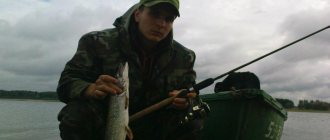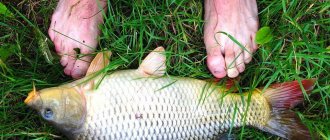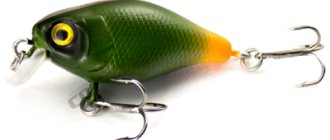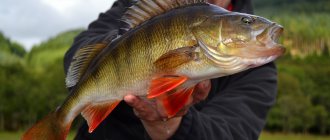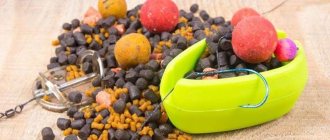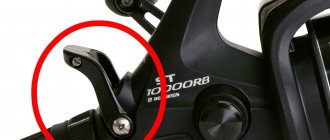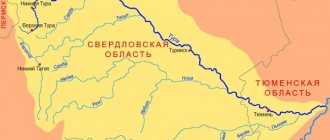Feeder equipment - this is the connection of a fishing weight-feeder, a thin leash and a hook on a fishing line using several knots. The main purpose of feeder rigs is to achieve high sensitivity of the rod tip to the touch of the fish, create the effect of self-hooking fish, camouflage the feeder and fishing line.
In this article, we have collected 11 of the most popular feeder rigs and made a classification according to the conditions of fishing on the feeder - for flow on a river and in conditions of standing water on a pond or lake. They gave recommendations on the choice of equipment for all types of carp fish: crucian carp, carp, bream, silver bream, sabrefish and 10 other popular fish, including predatory ones.
See photos and video instructions to tie any of the feeder rigs with your own hands correctly, and get significantly more bites when fishing due to the sensitivity of the gear.
Table for selecting feeder equipment according to fishing conditions
| Fish | Reservoir, bottom character | Catching equipment |
| Carp | pond, silt | Method ↓ |
| river, silt | Method ↓ | |
| river, hard bottom | Inline ↓, Asymmetrical loop ↓ | |
| Carp | river, silt | Method ↓ |
| river, hard bottom | Inline ↓, Asymmetrical loop ↓ | |
| crucian carp | pond, silt | Method ↓, Symmetrical loop ↓ |
| river, silt | Paternoster | |
| river, hard bottom | Asymmetrical loop ↓ | |
| Bream and silver bream | pond, silt | Method ↓ |
| river, silt | Helicopter and two knots ↓ | |
| river, hard bottom | Asymmetrical loop ↓ | |
| Roach | pond, silt | Paternoster |
| river, silt | Symmetrical loop ↓ | |
| river, hard bottom | Helicopter and two knots ↓ | |
| White amur | pond, silt | Method ↓ |
| river, silt | Method ↓ | |
| river, hard bottom | Asymmetrical loop ↓ | |
| Tench | pond, silt | Method ↓, Symmetrical loop ↓ |
| river, silt | Paternoster | |
| river, hard bottom | Asymmetrical loop ↓ | |
| Bleak and Chekhon | fishing near the surface | Helicopter and two knots ↓ |
| shallow fishing | Helicopter and two knots ↓ | |
| Chub | pond, silt | Helicopter and two knots ↓, Floating equipment ↓ |
| river, silt | Helicopter and two knots ↓, Floating equipment ↓ | |
| river, hard bottom | Helicopter and two knots ↓, Floating equipment ↓ | |
| Vobla | pond, silt | Paternoster ↓ |
| river, silt | Symmetrical loop ↓ | |
| river, hard bottom | Helicopter and two knots ↓ | |
| Trout | river, hard bottom | Helicopter and two knots ↓ |
| Pike | river and pond, hard bottom | Helicopter and two knots ↓ |
| Zander | river, hard bottom | Helicopter and two knots ↓ |
| Som | river, hard bottom | Inline ↓ |
| Burbot | river, hard bottom | Inline ↓ |
Important components of feeder equipment and their properties
Main line. When installing a feeder fishing rod, monofilament fishing line is used. We recommend paying attention to the following brands: Mikado Sensei Feeder, Trabucco T-Force feeder, Shimano Technium.
The diameter of the monofilament is 0.2-0.24.
Mikado Sensei Feeder. Price: 180 rub.
Trabucco T-Force Feeder. Price: 350 rub.
Shimano Technium. Price: 1150 rub.
We do not recommend the brands Salmo, Colmic, Gamakatsu, Owner, Suffix due to their insufficient hardness. In feeder fishing, it is very important that the line does not stretch. This allows the tackle to remain sensitive to bites and accept even the smallest touches of the fish on the tip of the rod.
Attention! Why don't we use braided line?
The fact is that feeder fishing involves constant rubbing of the fishing line on the bottom of the reservoir. Braid is susceptible to rapid abrasion, while monofilament, on the contrary, practically does not deform when in contact with gravel, stones and snags.
However, quality braided line is used in competitive fishing. If you want, we recommend Pontoon 21 Extreama 0.14-0.16 mm. Price: 1050 rub. for 100 m.
Fluorocarbon leashes. The hook is tied to a fluorocarbon line (fluorocarbon) for two reasons:
- This line is almost invisible in the water and does not scare the fish.
- It has increased rigidity, and this reduces the tangling of equipment. The length of the leads, depending on the equipment, is 10-100 cm. For example, in the Method equipment it is 10 cm, and in the Helicopter and two knots it is 100 cm.
Best models: Pontoon 21 Grand Fluorocarbon and Owner Broad Game Pro 0.1-0.31 mm.
Pontoon 21 Grand Fluorocarbon. Price: 655 rub. Owner Broad. Price: 330 rub.
There are ready-made leashes on sale: Owner RL 340 (thin hooks for bream), RL 330 (yellow hooks for corn), RL 044 (dark hooks for a worm). A choice for those who do not want to knit a leash with a hook and make a loop to the rig themselves.
Thickness of leashes. For a leader with a hook, use 0.1-0.2 mm depending on the weight of the intended fish. Up to 1 kg of production, 0.1 mm of fluorocarbon will be enough for you. The Running Feeder Rig and some others use a 0.3mm rigid fluorocarbon line take-off.
Swivel with carbine. It is important to choose a swivel commensurate with the feeder feeder, especially when using non-branded models. We recommend using an Owner swivel No. 14 when using a feeder larger than 60 g, and when fishing in still water using a small feeder - No. 12.
Important! Use a swivel only in black or dark colors, but never gold. Bright elements of equipment can scare away fish.
Crimping tube for loops
Crimping tube. An optional element, but can be used to make some equipment that uses thick monofilament fishing line. The crimp tube helps secure the hook to the fishing line without using knots at all. Nevertheless, we advise beginners to study the basic nodes and use them first.
Feeder. In total, 7 types of feeder weights are used in feeder gear, differing in their design. Key parameters to pay attention to:
- Feeder shape. Round and spiral are suitable for fishing in still water and in the absence or very weak current. Square and flat feeders are ideal for fishing in the current, as their shape does not allow the current to move the feeder from its place.
- Weight. Feeders up to 30 g are ideal for fishing in still water, and at the same time, you can throw such a load with a feeder rod at 50-80 m quite easily. For fishing in the current, use heavier feeders. Weight depends on the strength of the current and the depth of fishing. For example, in the Volga region on the Volga they use 120 g square feeders.
- Presence of thorns. Again, when fishing in the current, use feeder feeders with spikes.
- Shape and placement of the sinker. Important for the quality of self-tapping of feeder equipment. The more massive the side of the sinker is close to the hook, the harder it will be for the fish to move it, therefore the quality of hooking increases.
- Closed or open types. The closed feeder is designed for small feed that is easily sprayed into the water. The most popular are the spring and feeder for animal baits. Open - with a sharp pull, it is easily freed from the bait, pouring out in the right place. Varieties: cylindrical, rectangular, “curler”, container, “Method” (Method), with spikes and a bullet feeder that flies well.
Limit stop. The element is important for protecting the units from the heavy elements of our installations. Use hard rubber stoppers, soft plastic is a little worse, and it’s much worse to use beads as a stopper because of their hardness. Sooner or later they will damage the node.
Anti-twist tube. It is useful in equipment with the same name (the second name is “rocker arm” or “anti-twist tube”). Serves to move the fishing line with the leash to the side, which reduces the number of tangles in the equipment. They are used in currents and extremely rarely in still water due to the massiveness of the element.
Anti-twist tube and bead stopper
Hooks. Choose sharp, strong hooks that won't bend or break. Editor's Choice – Owner. The standard size for the feeder is No. 6-8. But for catching medium and small fish, they use up to No. 16 (roach, bream, silver bream), and when catching bleak on a floating rig - No. 20.
Hook sizes according to Owner classification
There are other elements, but they are used less often and we will talk about them further.
How to choose a feeder rod for a specific body of water.
The rod is your best friend when fishing. Whether you enjoy fishing or not depends on the correctness of your choice. Here we will look at all types of feeders in order to understand which rod is right for you.
The choice of feeder rod directly depends on the conditions in which you plan to fish. A large lake or a tiny backwater, a fast river or bay, a toll lake or reservoir. Each of the named reservoirs needs its own feeder
. • How to choose the first feeder
A feeder rod these days costs a lot of money, so you’re probably wondering – is there a universal option? We can say with confidence that there is no such option. Fishing conditions are dictated by feeders that are completely different in length, test and structure. Imagine for a second that you came to your grandmother to dig potatoes, and here is a lake with an area of 1 hectare. And how will you swing a 4-meter rod in such conditions? You’ll scare the crucians, and you won’t have time for potatoes after such nerves.
Universalism depends on fishing conditions. Let's look at them in more detail:
1. Small lake or river. A three-meter rod with a casting weight of up to 50 grams would be a universal option here. This type of fishing rod is called a picker.
2. A large lake or deep bay with minimal current. A rod 3.6 – 3.9 meters long, with a casting weight of up to 90 grams, will help you here. The type of feeder rod like this is called medium.
3. Large, fast-flowing river. Here a 4.2 meter long rod with a casting weight of 150 grams will come to your rescue. This rod can be classified as extra-heavy.
4. Reservoir. These artificial reservoirs are usually very large, but with minimal or no current. Giants for long-distance casting 4.5 long with casting up to 120 grams will be relevant here.
• Carbon vs composite
In this unequal battle, of course, carbon wins. Sensitivity, strength, light weight, total 3:0 in favor of carbon. The only thing that will help the composite score a goal of prestige is its more affordable price compared to carbon feeders.
A carbon feeder is not a Leningrad rod. A careful attitude is needed here. We strongly advise you to purchase a case so that you can transport your rod to the fishing spot without damage.
There are also fiberglass rods, but we advise you to stay away from them. If you want to save money, then composite is better. Fiberglass rods do not have good sensitivity and weigh a lot.
• For some bream, for others roach, and for others carp
The choice of feeder rod depends on the fish you want to catch. It’s one thing to go out to catch silver bream or roach in the middle of the day, and quite another thing to fish at night, hoping for a catfish bite. Here you should pay attention to the structure of the rod.
1. Fast build. It is good for fishing in the current; it is easy to use, and most importantly, it can accurately cast long distances.
2. Medium tuning. A more sensitive option that is suitable for tempo fishing for non-trophy fish.
3. Slow build. It dampens the jerks of large fish well and is perfect for catching carp on lakes where a long casting distance and super-accuracy of hitting the feeding spot are not required. For example, fishing with flat feeders on a silty bottom.
We conclude: if your goal is to catch a small white fish, then any medium-action feeder rod will do. The most popular option in this segment is a 3.6-long rod with a casting weight of up to 100 grams. If you want to catch large bream, carp, or catfish on rivers with a noticeable current, choose a fast-action rod, 3.9-4.2 meters long, with a weight of up to 180 grams.
• Feeder design
Feeders are plug-in and telescopic. We strongly recommend that you choose plug-in ones. They are lighter and stronger. The only advantage of telescopic feeders is that they are easy to transport.
When purchasing a feeder, we advise you to pay attention to the rings. If you plan to fish with a line, then the rings should have a Sic insert. A large number of rings on the feeder is a significant plus, since the load will be evenly distributed throughout the feeder form.
The reel seat and handle are not the primary factors when choosing a feeder, but if the rod “feels in your hand,” this will be an additional advantage in choosing this option.
• We draw a conclusion
Now there is a very wide selection of feeder rods from different manufacturers on the market. Make your choice based on the above tips in favor of a well-known brand. After all, fishing is, above all, pleasure. If the rod transmits every jerk of the fish when fishing, you will receive a priceless gift - a lifelong memory of a happy time spent on a pond.
Making carp rigs with your own hands
We have already touched on the topic of carp rigs superficially. Now let's look at them in more detail.
Carp installation “Safe clip”
Safety clips are an element that attaches the sinker to the fishing line, facilitating the easy release of the fish from the sinker if the main line breaks.
This equipment has advantages over other equipment when fishing in snags, since the load is secured in a safe clip, which guarantees detachment under strong tension.
We will need:
- Leadcore (thickness 45 lb). This element has a braid and a lead core. It plays the role of weighting the equipment at the bottom so that the fishing line does not hang in the water column and does not scare the fish. The second role of leadcore is that it is a safer material for fish when playing. The carp will not be scratched during sharp maneuvers because the material is soft and thick.
- Mounting needle for leadcore.
- Quick release with swivel.
- Safety clip (Safety Clips, with a lock for blind equipment or sliding) - plastic or metal. The disadvantage of plastic is that it breaks during forceful casting. There are also metal options on sale, try it.
Instructions:
- We fix the leadcore in the needle. To do this, take out a core about 3 cm long from it and bite it off with tongs. Return the braid to its original place and bend the leadcore where the core ended. At the bend, pierce the leadcore with a needle and bring it out after 2 cm towards the tip.
- We put the swivel on the tip of the leadcore, and then hook the hook of the needle on this very tip and begin to move the tip of the leadcore inward with slow rotational movements left and right - forming a loop.
- Cut off the extra piece of the tail, leaving a little more than 1 mm. We tighten it very tightly. The harder you pull, the more firmly the braids will be attached to each other and will not unwind.
- We drip a drop of Moment Pro glue in the place where the leadcore shell went inside for an additional guarantee of strength.
- The length of the leadcore will be 60 cm. We perform the same operation from stages 1 to 4 on the other side. And yes, the presence of leadcore greatly distinguishes carp rigs from classic feeder rigs.
- We insert the needle into the clip from the side where we will have the cone, fasten the leadcore into the needle and pull it through the clip to the very end.
- The clip is put on the swivel on the other side of the leadcore. It is important to secure the swivel in the clip using a small plastic quick release, this is part of the clip itself.
- Step No. 7 is also done with the cone for the clip.
- We put the sinker on the clip and fix it with a cone.
Carp equipment Inline (Inline)
There are many types of Inline installations described on the Internet, and most of them structurally replicate the Running Feeder Rig. But historically, Inline is a carp rig for carp fishing (waiting) fishing, not feeder fishing. In carp fishing, a feeder tip is not used as a bite alarm, but a bite is detected by an electronic alarm. When the line is released from the reel, the alarm makes a sound. Naturally, this is a sliding equipment, which means it is sporty.
Inline is suitable for fishing on rocky hard bottoms and shell rocks. Unsuitable for fishing in snags, since the sinker does not shoot off under strong tension. It's also bad on muddy bottoms.
Feeder installation Inline is very good at self-hooking carp and carp due to the drop-shaped shape of the sinker. The part of the sinker close to the leader has a thickening, which gives much more resistance to lifting from the bottom. Consequently, the hook with the sinker is sharper.
You will need:
- Inline cargo
- Leadcore (with or without core) length 60 cm
- The needle is thin for leadcore
- Large broaching needle
- Scissors and glue
- Swivel
Instructions:
- We form a loop at one of the ends of the leadcore (we use leadcore without a core). Apply glue to fix the loop.
- We fasten the swivel using the “loop-to-loop” method.
- We insert the mounting needle into the Inline sinker from the side of the connector tube (narrow part), and attach the free tip of the leadcore to the needle. We tighten the swivel inside the sinker by pulling on the free tip of the leadcore.
- The leash is attached to the swivel using the loop-to-loop method or another reliable knot.
Fishing on a feeder. Reservoirs without current
Published: December 18, 2014 Category: Author's essay
Fishing on a feeder. Reservoirs without current
Let's make a reservation right away. Reservoirs without a current vary greatly. It is difficult to compare feeder fishing in a shallow reservoir, where the water temperature in summer is almost always close to the optimum, and fishing in an abandoned clay quarry with depths of up to 30 meters, where the water warms up only in the upper layer (about one meter), and freezing cold reigns in the depths.
But there are common features in the behavior of fish in all bodies of calm water:
1. The fish looks for places with optimal water temperature (18 – 21 degrees).
2. Any change in the bottom topography is of interest to fish.
3. If there are predatory fish in a reservoir, peaceful fish should be looked for at the boundaries of aquatic vegetation and clean water.
Intelligence service
A feeder who decides to develop a reservoir without a current must remember a few simple rules:
1. Reconnaissance of a reservoir can be carried out in various ways. But on bodies of water without a current, it is more convenient to measure the depths with a depth gauge, marker gear or using an echo sounder.
2. Any differences in depth in the selected location are recorded. On lakes of various sizes and depths, “tables” and small holes are especially interesting. On reservoirs and ponds, places of interest to the feeder can most often be found on the slopes of a flooded riverbed.
Fishing on a feeder. Reservoirs without current. Fishing place
The place for casting must be equipped: clear the place in such a way that nothing interferes with casting. Place stands under the rod and cover the area on the ground so that you can put the rod down without any consequences.
Fishing in reservoirs without a current is not as dynamic as river fishing; it is better to refrain from moving to a new place. Therefore, you can sit comfortably by installing a fishing chair or a small folding chair.
One of the advantages of paid reservoirs is that the fishing area is prepared by default.
Groundbait mixture
The requirements for bait mixture in feeder fishing on reservoirs without current have some differences from the bait mixture used in river fishing:
1. It should be less viscous in order to disintegrate in water on its own.
2. The bait mixture used in reservoirs without current must contain ingredients that have neutral and positive buoyancy. The bait, disintegrating in the water, should create a bait cloud visible from afar.
3. Fragrances must be used very carefully in stagnant water. Any overdose of this component of the bait can scare away the fish for a long time.
To make the bait cloud more noticeable, some anglers use yogurt during the mixing process, which is also a flavoring agent. And vanilla or strawberry cookies are used as a baking powder.
On paid reservoirs, it is better to include in the bait a mixture that the fish knows - what the staff serving the reservoir feeds the fish.
Fishing on a feeder. Reservoirs without current.Bait
Preliminary bait at short distances on reservoirs without a current usually does not cause problems even for novice fans of feeder fishing.
Just like in river fishing, you need to prepare at least 5 kg of bait in advance. A third of this mass must be sent into the water before fishing begins. Some fishermen recommend using up to half of this mass at a time.
In reservoirs where the main fish is bream, this is a completely reasonable tactic. If the hunt is for crucian carp or tench, then there is no need to waste bait. These fish are still among the last to be baited, after there are fewer small fish in the feeding area.
At short distances, bait can be presented by hand or with a large (in volume) feeder. Typically, anglers are able to cast bait more or less accurately to create a limited, concentrated spot of bait on the bottom and a stable cloud of bait above the surface of the bottom.
At long distances, bait can be fed using a slingshot or the same large feeder. But in order to set a reference point for long-distance casting, a marker tackle is used, with a heavy sinker and a large float visible from afar.
You can also use sawdust, which is previously added to the bait mixture, as a guide. Having positive buoyancy, they:
- help the bait disintegrate faster;
- floating to the surface, they will accurately indicate the location of the bait on the bottom.
On reservoirs without a current, you can change the bait in the feeder once every 15 minutes.
Fishing on a feeder. Reservoirs without current. Tackle
It will not be a secret that fish in bodies of water without a current are more cautious than their river sister.
We select a fishing rod based on specific fishing conditions. We select the reel based on the capacity of the spool and the casting length. A mandatory requirement for a feeder reel is the presence of a well-adjusted friction brake.
If possible, we color the main fishing line (or buy it colored) so that it blends in with the color of the bottom of the reservoir.
Many anglers ask the question: “What is better to use in feeder equipment: fishing line or braid?”
The answer is simple: “Depending on the circumstances.”
If the bottom of the reservoir is clean and the water is clear, then it is better to use monofilament fishing line. It is transparent and better absorbs the jerks of the fish.
Braided cord must be used in places where strength may be required from the fishing line. For example, in places where aquatic vegetation can make it very difficult to catch fish.
The leading line should be as strong and thin as possible. The recommended material is fluorocarbon. The material in water is almost invisible and stretchable.
The most difficult thing in choosing gear on reservoirs without current is choosing the right feeder. It is imperative to find out the nature of the bottom in the fishing area. The methods are exactly the same as in river fishing with a feeder.
In reservoirs with a viscous, muddy bottom, the main feeder must be made of plastic, with a light, large base - a flat feeder.
In ponds with a hard bottom, you can use familiar feeders made from welded fine mesh.
Bait
In any body of water, fish have their own preferences, which depend on the time of year, water temperature, and the vegetation that can be found on the banks of the reservoir. When choosing bait, you need to navigate and take into account all these factors. Bait particles must be contained in the bait.
Fishing on a feeder. Reservoirs without current. Fishing
The bite of lake fish, if you are not catching carp or large bream, is careful. Usually the tip trembles slightly or bends very slightly.
It is difficult to advise the timing of cutting. Each angler has his own tactics. I would like to advise beginners, at first, not to rush and wait for an obvious bite, when the quiver either reliably bends or straightens.
The force of the hook should depend on the distance to the bait and the type of main line. The farther the bait was from the shore, the sharper the hook should be.
After hooking, it is better to loosen the friction brake, raise the rod vertically and slowly reel in the line.
A loose clutch will allow the fish to pick up the line during jerks. There is no need to rush into landing fish (especially if it is large). We need to wait until she gets tired. The friction and rod tip will help dampen jerks. Near the shore, the fish can be caught in a landing net or by hand. Articles about fishing 0
Improvement of equipment
Feeder Gum, Power Gum
Feedergam dampens sudden jerks of fish. This is a piece of rubber between the feeder equipment and very thin fluorocarbon leaders (for example, 0.1 mm).
Feeder rubber is important for creating a shock-absorbing effect in the equipment. This is especially important when using the main cord - braid. Length – 10-12 cm, thickness 0.6-0.8. Feeder Gum provides delicate fishing with very thin fishing line (0.1 mm).
Installation:
- Pull the feederham. When the knot is pulled together, it will return to its original state and give the knot greater strength.
- Make loops on the feedergam using a figure eight knot on both sides of the elastic.
- The feeder will be an intermediate link between any of the rigs and a fluorocarbon leader. Everything is attached using the “Loop to Loop” method.
Important:
- Don't make the feeder ham long. Up to 15 cm is ideal. 30 cm is too much. The longer the rubber, the more the equipment gets tangled and the less sensitive the equipment is.
- Don't use colored rubber bands. Take transparent ones. This doesn't scare the fish.
- Do not glue the elastic knots. This eats away at the feeder.
- Lighten your feeder rigs. Do not use swivels when attaching swivels. Only using the “Loop to Loop” method. This will reduce weight and reduce the amount of debris that can be caught from the bottom by unnecessary elements in the installation.
Asymmetrical loop + feedergam = the best combination.
Protection of equipment from snagging
In order to protect the equipment from getting snagged on snags or falling through stones, reduce the thickness of the fishing line on which the feeder weight is attached. If you get hooked, you will lose the feeder, but if there was a fish on the hook, you will fish it out.
Applicable in snap-ins:
- Paternoster and Gardner's loop.
- A helicopter and two knots, if you knit a large loop on a thinner line.
On Inline, Method rigs - use a safe clip. Once caught, it will come unfastened.
How to equip a feeder rod with a reel and equipment
Coil
To equip the feeder, specially produced reels are used, but if one is not found, a regular spinning reel will do. Below are the recommended parameters that your reel should have:
Reels are divided into high-speed and power types, according to gear ratios. We need something in between. A reel with a gear ratio up to 4.6 is a power reel, and a reel with a gear ratio above 5.5 is a high-speed one. Reels with gear ratios ranging from 4.6 to 5.5 are just right for us.
Let's move on to the bobbin. Usually the universal size is 3000. For us, from 2500 to 4000 is suitable. By the way, when choosing a reel, inquire about the presence of a spare spool in the kit; if it is not there, ask which models are on sale separately and buy it, believe me, it will come in handy.
When fishing with a feeder, the probability of a sharp jerk is very high, and, accordingly, the line will break. We don’t need this, so we make sure that our reel is equipped with a friction brake. The clutches are front and rear. The rear clutch is less sensitive and is easier to use in feeder fishing, while the front clutch is more often installed on spinning reels. There is not much difference - who is more comfortable working with what.
The reels use ball bearings, some models can have up to fifteen of them. There is no need to chase quantity - those with 5-6 bearings are quite suitable for us, but no less, because the device has at least 5 elements that are very susceptible to abrasion.
We can recommend the following models:
- Shimano BAITRUNNER 4000 D up to 5000 rub.
- Okuma LONGBOW BAITFEEDER 50 to 2000 rub.
Okuma LONGBOW BAITFEEDER 50 with baitrunner - budget quality reel
Let's move on to the issue of choosing fishing line
The debate about which is better - monofilament or braided line - still continues. Let's look at the advantages and disadvantages:
- Braid has an advantage that there is no point in arguing with: it is very sensitive, tapping the bottom to determine the location of future fishing, transmitting a bite - in this it is better. But since very often fishing occurs in places where shells accumulate, on the edges, the likelihood that the line will be “cut” increases greatly. And just the braid has a much greater chance of being cut off. But good fishing lines have abrasion protection, for example, Salmo Elite Braid 0.13, we recommend.
- Monoline - It may not be as sensitive, but it is less susceptible to the chance of being cut off by barnacles or anything else. Plus, stretching plays an important role if you catch large and strong fish. Good fishing lines are produced by Salmo; they have a Feeder line.
If you haven’t decided on your own which fishing line to choose, take monofilament if you don’t catch crucian carp. Braid is still better for him because of his very weak touch to the bait. Choose a monofilament line with the lowest stretch and preferably a dark color (this is used by carp fishermen for good reason, it is not visible at the bottom).
For leashes, use high-quality fluorocarbon fishing line that is invisible in the water.
Equipment is the heart of the feeder
The simplest equipment with which to start studying a feeder is a paternoster. It consists of a loop into which the feeder is threaded and a leash on which the hook is attached.
The equipment is made as follows:
- We take the main fishing line and tie a loop for the leash at the tip.
- Next, place your palm along the length of the first loop and knit a second loop at the end of the palm. The size of the second loop should be such that the feeder fits into it.
- We attach the feeder - we pull a large loop through the swivel and throw it on the feeder itself. We fix the line on the swivel itself. Using the “loop-to-loop” knitting method, we attach a leash with a hook to the second small loop.
- "Paternoster" is ready.
Video for clarity:
Now let's talk about feeder rigs for catching bream in the current, carp and crucian carp.
Take action!
- Equip your feeder rod with a rigid, inextensible monofilament line, for example, Mikado Sensei Feeder 0.24 mm 150 m . This will increase the number of bites.
- Decide on fishing conditions. Let's say we want to catch bream on the Volga . This river usually has a current and a hard bottom, so we will use a Helicopter feeder rig and two knots . Assemble it directly on the main line according to our instructions from this article. It will take no more than 10 minutes.
- Since fishing takes place in the current, at great depths and at a distance of at least 50 m from the shore, you should choose a feeder weighing from 80 to 120 g . Choose a square shape with spikes so that the feeder does not slide along the bottom.
- a fluorocarbon leader 0.3 mm thick and 1 m long to the feeder rig . At the end there is hook No. 8 according to international numbering. Bream does not have a very large mouth, so small hooks should be used.
- a bunch of maggots as bait . Bream really loves bunches of 5 or more pieces.
- The bait must contain sweet ingredients (vanillin, chewing gum flavor, cake).
- After catching a fish, not necessarily bream, please share your experience here in the comments below the article. Thanks for reading!
Feeder equipment for catching bream in the current
- For catching bream, a “Medium” or “Heavy” rod is suitable, test 90-120 grams
- We choose braided fishing line with a strength of 10 lb, or monofilament with a thickness of 0.25.
- Leash made of fishing line 0.16-0.18 mm. If there are shells on the bottom, it is better to use fluorocarbon fishing line. The thickness of fluorocarbon should be equal to the thickness of the main line, because it is weaker at break.
- The hooks are large enough to fit into the fish's mouth. You must know what kind of bream is found in your river. Usually this is from No. 6 to No. 12.
- It is better to take a square open type feeder, weighing 70-120 grams, depending on the strength of the current and the depth of fishing. The stronger the current and the deeper the place, the heavier the feeder is needed. And the open type allows you to feed the fishing spot much faster.
- We recommend using an asymmetrical loop type of equipment, although a paternoster, of course, is also suitable. Also take a closer look at the unusual equipment: a helicopter and two knots. It allows you to fish in strong currents with a hook hovering above the bottom.
- As bait you can use: steamed pearl barley and wheat, steamed millet, peas, canned corn, bloodworms, maggots, chopped shell and worm meat.
- And we have a detailed guide about bait.

